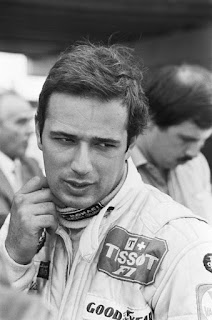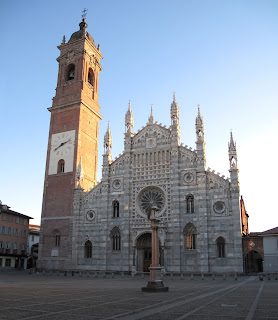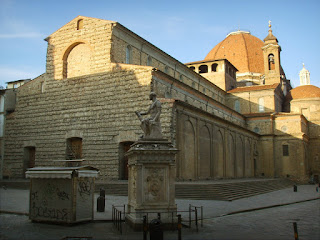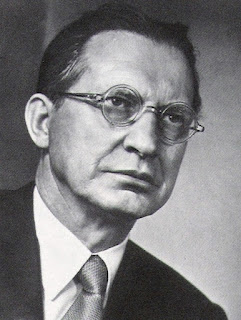Founder of Italy's famed Bersaglieri corps
 |
| A painting, by an unknown artist, that shows General Alessandro La Marmora, in his Bersaglieri uniform |
Alessandro Ferrero La Marmora was one of 16 children born to the Marquis Celestino Ferrero della Marmora and his wife Raffaella. The family had a strong military tradition. Alessandro was one of four of the male children who grew up to serve as generals.
La Marmora was a captain when he came up with the idea for the Bersaglieri in 1836.
He had spent much time in France, England, Bavaria, Saxony, Switzerland, and the Austrian county of Tyrol studying armies and tactics and he approached King Carlo Alberto of Piedmont-Sardinia with the idea of creating a new corps of light infantry.
He envisaged a mobile elite corps similar to the French chasseurs and Austrian jägers, trained to a high physical level and all crack marksmen. He suggested they should act as scouts, providing screen for the main army, operate as skirmishers and use their sharpshooting skills to weaken the flanks of the enemy during a battle.
From this proposal emerged the Bersaglieri, soldiers who were trained to be bold, carrying out their duties with patriotic fervour despite personal danger.
 |
| A painting by Carlo Ademollo from 1880 shows Bersaglieri soldiers storming Rome's Porta Pia in 1870 |
The other feature of the Bersaglieri was that, on parade, they moved in a fast jog rather than marching.
The feathers were important to morale, reinforcing belief in corps members that they were a force to be reckoned with against any opposing troops. Battlefield helmets carried about 100 plumes compared with 400 on dress helmets.
The feathers served a practical purpose, too. Worn on the right side of the hat, they helped shade the shooting eye of the soldier as an aid to taking aim. Also, because adornments to military headgear were normally worn on the left, they had the potential to confuse enemy spotters over the direction in which they were moving.
When, during the First World War, it was decided that feathers would make the Bersaglieri too conspicuous in trench warfare and the corps were ordered to wear plain tin helmets, morale suffered so much that the order had to be reversed.
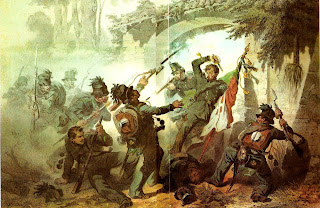 |
| Bersaglieri in action at the Battle of Novara |
Led by La Marmora, the Bersaglieri distinguished themselves during the First Italian War of Independence by storming a bridge in the Battle of Goita - in which La Marmora suffered a broken jaw when he was shot in the face - and became famous on September 20, 1870 when they charged through a breach in the walls of Rome at Porta Pia. Their assault led to the capture of the city, completing Italian unification.
Elements served in the expeditionary force sent by the Kingdom of Piedmont-Sardinia to Russia during the Crimean War and during the First World War many Bersaglieri saw service on the front with Austria and in the Middle East. Their valour and bravery was noted.
In the Second World War, although largely disastrous for Mussolini's armies, the Bersaglieri regiments performed so effectively they not only impressed Italy's German allies, particularly during the North African campaign, but also their adversaries on the Allied side.
Today's Bersaglieri regiments are no longer foot soldiers but mechanised units. They have served as peacekeepers in the in Lebanon, Yugoslavia and in the Somali civil wars, and were also active in Operation Iraqi Freedom.
 |
| A modern Italian Bersagliere in the service of Nato |
In 1849, he was appointed Chief of Staff of the army and inspector of the Bersaglieri. He was in charge of the division stationed in the Ligurian city of Genoa and at the command of his brother Alfonso, the Royal commissioner, who had been sent to quell an anti-monarchy revolt.
In 1852 Alessandro was regular commander of the military division of Genoa and in the same year was promoted by King Vittorio Emanuele II to lieutenant general. He stayed in the Ligurian capital until 1854, when he married Rosa Roccatagliata,
In 1855, at the age of 56, he was lieutenant general in command of the second division of the army corps sent to the Crimea, but died at Balaklava from cholera. A memorial bust was erected outside among the statues and monuments of patriots on the Janiculum Hill in Rome.
 |
| Porta Pia and the monument to the Bersaglieri in Rome |
The achievements of the Bersaglieri are commemorated in Rome at the Historical Museum of the Bersaglieri, which was inaugurated by King Victor Emanuel III in June 1904, at the La Marmora barracks in the Trastevere district. From May 1909 it housed the medals won by the Bersaglieri corps. The museum was moved to the area of Porta Pia in 1921.
Travel tip:
In addition to the bust at the Janiculum Hill in Rome, La Marmora is commemorated in Turin with a statue in bronze in the Giardino La Marmora on Via Cernaia in the centre of the city. The statue, which shows La Marmora in action with his sword drawn, was created in 1867 by the sculptors Giuseppe Cassano and Giuseppe Dini.
More reading:
How the capture of Rome completed Italian unification
Italy's decisive victory of the First World War
The Milanese uprising that drove out the Austrians
Also on this day:
1969: The birth of Gianluigi Lentini, once the world's most expensive footballer
Home

